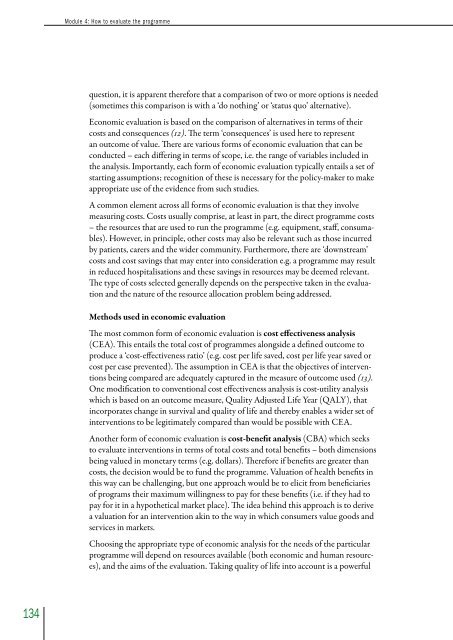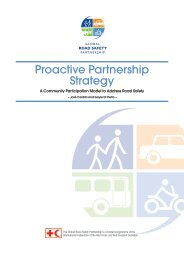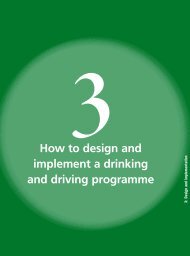How to evaluate the programme - World Health Organization
How to evaluate the programme - World Health Organization
How to evaluate the programme - World Health Organization
Create successful ePaper yourself
Turn your PDF publications into a flip-book with our unique Google optimized e-Paper software.
Module 4: <strong>How</strong> <strong>to</strong> <strong>evaluate</strong> <strong>the</strong> <strong>programme</strong><br />
question, it is apparent <strong>the</strong>refore that a comparison of two or more options is needed<br />
(sometimes this comparison is with a ‘do nothing’ or ‘status quo’ alternative).<br />
Economic evaluation is based on <strong>the</strong> comparison of alternatives in terms of <strong>the</strong>ir<br />
costs and consequences (12). The term ‘consequences’ is used here <strong>to</strong> represent<br />
an outcome of value. There are various forms of economic evaluation that can be<br />
conducted – each differing in terms of scope, i.e. <strong>the</strong> range of variables included in<br />
<strong>the</strong> analysis. Importantly, each form of economic evaluation typically entails a set of<br />
starting assumptions; recognition of <strong>the</strong>se is necessary for <strong>the</strong> policy-maker <strong>to</strong> make<br />
appropriate use of <strong>the</strong> evidence from such studies.<br />
A common element across all forms of economic evaluation is that <strong>the</strong>y involve<br />
measuring costs. Costs usually comprise, at least in part, <strong>the</strong> direct <strong>programme</strong> costs<br />
– <strong>the</strong> resources that are used <strong>to</strong> run <strong>the</strong> <strong>programme</strong> (e.g. equipment, staff, consumables).<br />
<strong>How</strong>ever, in principle, o<strong>the</strong>r costs may also be relevant such as those incurred<br />
by patients, carers and <strong>the</strong> wider community. Fur<strong>the</strong>rmore, <strong>the</strong>re are ‘downstream’<br />
costs and cost savings that may enter in<strong>to</strong> consideration e.g. a <strong>programme</strong> may result<br />
in reduced hospitalisations and <strong>the</strong>se savings in resources may be deemed relevant.<br />
The type of costs selected generally depends on <strong>the</strong> perspective taken in <strong>the</strong> evaluation<br />
and <strong>the</strong> nature of <strong>the</strong> resource allocation problem being addressed.<br />
Methods used in economic evaluation<br />
The most common form of economic evaluation is cost effectiveness analysis<br />
(CEA). This entails <strong>the</strong> <strong>to</strong>tal cost of <strong>programme</strong>s alongside a defined outcome <strong>to</strong><br />
produce a ‘cost-effectiveness ratio’ (e.g. cost per life saved, cost per life year saved or<br />
cost per case prevented). The assumption in CEA is that <strong>the</strong> objectives of interventions<br />
being compared are adequately captured in <strong>the</strong> measure of outcome used (13).<br />
One modification <strong>to</strong> conventional cost effectiveness analysis is cost-utility analysis<br />
which is based on an outcome measure, Quality Adjusted Life Year (QALY), that<br />
incorporates change in survival and quality of life and <strong>the</strong>reby enables a wider set of<br />
interventions <strong>to</strong> be legitimately compared than would be possible with CEA.<br />
Ano<strong>the</strong>r form of economic evaluation is cost-benefit analysis (CBA) which seeks<br />
<strong>to</strong> <strong>evaluate</strong> interventions in terms of <strong>to</strong>tal costs and <strong>to</strong>tal benefits – both dimensions<br />
being valued in monetary terms (e.g. dollars). Therefore if benefits are greater than<br />
costs, <strong>the</strong> decision would be <strong>to</strong> fund <strong>the</strong> <strong>programme</strong>. Valuation of health benefits in<br />
this way can be challenging, but one approach would be <strong>to</strong> elicit from beneficiaries<br />
of programs <strong>the</strong>ir maximum willingness <strong>to</strong> pay for <strong>the</strong>se benefits (i.e. if <strong>the</strong>y had <strong>to</strong><br />
pay for it in a hypo<strong>the</strong>tical market place). The idea behind this approach is <strong>to</strong> derive<br />
a valuation for an intervention akin <strong>to</strong> <strong>the</strong> way in which consumers value goods and<br />
services in markets.<br />
Choosing <strong>the</strong> appropriate type of economic analysis for <strong>the</strong> needs of <strong>the</strong> particular<br />
<strong>programme</strong> will depend on resources available (both economic and human resources),<br />
and <strong>the</strong> aims of <strong>the</strong> evaluation. Taking quality of life in<strong>to</strong> account is a powerful<br />
134

















